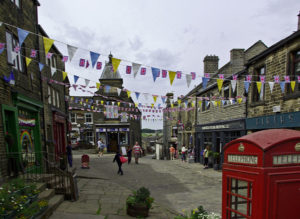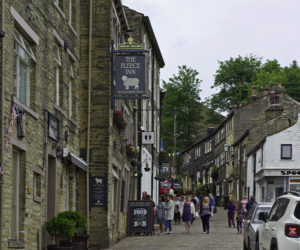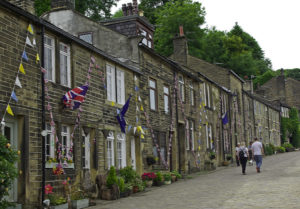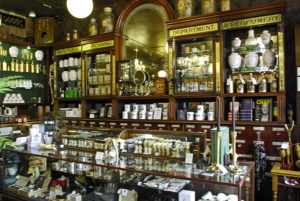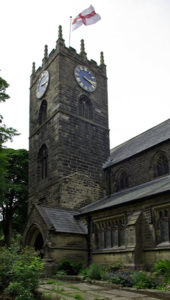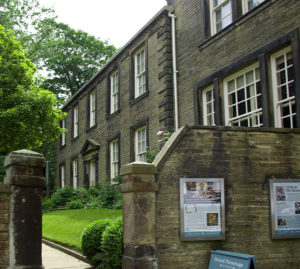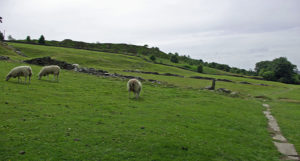Haworth is a hilltop village set above the steep Worth Valley on the edge of the windswept Pennine Moors. You can almost feel the spirit of the Bronte sisters here. The cobbled streets of the old town climb up to the Church and Parsonage at the top of the hill. Below, spread out along the valley bottom, are the mills that provided employment and prosperity in the C19th, served by the Keighley and Worth Valley railway.
Haworth is very much on the tourist trail and is visited by thousands of people for its connections with the Bronte sisters. Younger visitors are probably more interested in the Railway Children connections as many of the “scenes”:http://movie-locations.com/movies/r/Railway-Children.php of the iconic 1970 film were shot in the area. The “Keighley and Worth Valley Railway”:https://kwvr.co.uk/rail-story/ features prominently in the film and there is even a “Railway Children Walk”:http://mediafiles.thedms.co.uk/Publication/YS-Brad/cms/pdf/railwaychildrenwalk.pdf to follow.
Most people arriving at Haworth head straight up the very steep Main Street for the church and Parsonage. This is lined with old stone built houses with stone slab roofs. Many of the windows are later additions, replacing earlier and smaller windows. Some still retain their weaver’s heritage, with the big top floor windows giving light for the hand looms.
Tourism is big business and there are many cafes and tourist shops along here. Tourist Information is in the small square at the top of the street, which still has one of the remaining iconic red telephone boxes.
The Black Bull is the pub where Branwell drank. Across the road is the Apothecary’s Shop where he bought his opium. This has now been restored to its former glory as the Cabinet of Curiosities with antique fittings and selling a range of lotions, balms and soaps all based on traditional recipes
“St Michael and All Saints’ Church”:http://wasleys.org.uk/eleanor/churches/england/yorkshire/west_yorkshire/haworth/index.html is reached up steps off Main Street and is surrounded by a large and now disused graveyard full of gently collapsing graves. It is estimated over 40,000 people were buried here. This overcrowding along with poor drainage affected the sanitation in the village. Nearly half the children died before the age of six and the average age was only 24. The graveyard was closed in 1883 and a new cemetery built outside the village.
The church dates from the late C19th as the church where Patrick Bronte preached and Emily, Anne and Charlotte attended was proclaimed as unsafe and unsanitary after the death of Patrick. Even though there was a national outcry it was demolished. Only the base of the tower survives along with the communion table and chandelier in the Bronte Chapel inside the present church. A bronze memorial in the floor marks the site of the Bronte Family vault where all the family apart from Anne are buried.
The Parsonage stands above the churchyard and has been preserved as the “Bronte Parsonage Museum”:https://www.bronte.org.uk/ . It is a lovely Georgian building and the rooms are furnished as they would have been when the Brontes lived here, with their furniture, clothes and personal possessions.
Between the Parsonage and the Church is the old school room. This was built by Patrick who was a great believer in the importance of education. All his children taught in the school. This now hosts craft fairs, exhibitions and meetings.
From the Parsonage, a footpath leads out across the moors. This was a favourite walk of the Bronte sisters and lead to a small waterfall and continues to the ruins of Top Withens Farm, which is thought to have been the inspiration for Emily Bronte’s Wuthering Heights.
The settlement along the bottom of the valley is newer than that at the top of the town and has a more workaday feel to it. Shops are used by locals and there are few concessions to tourists here. “Platform 4 Sandwich Station”:https://take-a-way.co.uk/menu/8422/Platform%204%20Sandwich%20Station%20-%20Haworth/ provides a good cheap take away service welcomed by railway staff as well as visitors.
The “Keighley and Worth Valley Railway”:https://www.silvertraveladvisor.com/travel-product/attraction/137961-keighley-and-worth-valley-railway is a five mile long branch line that runs from Oxenhope to Keighley. It was operated by the Midland Railway Company and served 15 mills along the valley bottom, as well as Haworth and Ingrow. The line closed in 1962 but was reopened again a few years later by enthusiastic volunteers. The stations are still painted in Midland Railway colours and it retains the feel of an inter war branch line, with an interesting selection of steam locos and diesel railbuses. There is a good view of the depot and assembled locos from the railway bridge on Bridgehouse Lane.
Despite the pressure of tourists, Haworth retains its character and atmosphere, particularly on a late December afternoon when the dusk is falling. It really does feel like stepping back 150 years.
